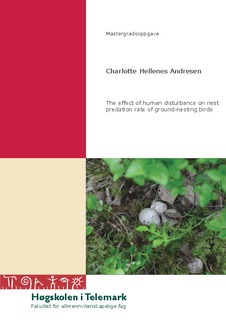| dc.description.abstract | A number of studies have shown that human disturbance can have a strong negative impact on the successful reproduction in birds. Ground-nesting birds are especially vulnerable to nest mortality due to trampling of nests, predation by loose dogs, or that parents abandon the nest because of extensive disturbance. However, nest mortality might also be the result of nest predation that occurs after the disturbance has seized. Predators are likely to eavesdrop human presence using visual, auditory or olfactory cues to home in on the location of nests. In this study I investigated if human disturbance would negatively affect the nest predation rate in ground-nesting birds. I predicted that a higher visitation rate would increase nest predation risk. To measure the response I used a total of 280 artificial nests that contained eggs from the Common Quail (Coturnix coturnix). The study was divided into two periods, and for each period two different habitats were used (forest and clear-cut). Visitation rates were divided into three groups: 1) nests visited every day, 2) nests visited every third day, and 3) nests never visited. A separate area (clear-cut) was also used to see if wildlife cameras had an effect on nest predation rate. I found that visitation rate had a significant effect on nest predation rate, with nests visited every day having almost twice the number of nests predated upon than nests that were never visited. Wildlife cameras did not seem to affect nest predation rate. The predation rate was highest for the forested area in the second period for all of the three visitation categories. The reasons for this could be distance to human settlements and agricultural landscape, and observation of both mammalian and avian predators at the study site. Previous studies have shown that nests placed on the ground close to human settlement have higher predation rate than nest placed in larger forest area, further away from human disturbance and settlements, and corvids are the most common predator of ground-nests, which could explain my results. There are no temporal trends and predation happens random through out the study period. This study illustrates that predation on ground-nests is strongly affected by daily human visits, in areas close to human settlement. Caution should be taken when visiting groundnesting birds, avoiding damaging area close to the nest and also not walking the same path to each nest upon visits and most important have as few visits as possible. | |
